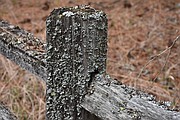Likin' lichens!
“There is a low mist in the woods ... it is a good day to study lichens”
— Henry David Thoreau Journal, 1851
Recently I hiked Chickadee Trail just north of the Kootenai National Wildlife Refuge district office. As I enjoyed exploring the early spring growth on the lush trail I observed lichens growing on the trees, wooden fence posts, and rocks.
When I stopped to study this phenomenon I was soon moved by the serenity of the pond, the sound of the creek and the smell of nature. On some of the rocks, trees and fence posts grew lichens in the shadows. It felt like a good place where there was an old magic.
Lichen is a simple, slow-growing plant that typically forms a low, crusty, leaf-like or branching growth on rocks, walls, and trees.
Not many people know what lichens are the first time they see them on a walk in the woods. At first glance it seems they are from the moon or a distant planet. Lichens are a bizarre organism and no two are alike.
Lichens are a complex life form that is a symbiotic partnership of two separate organisms, a fungus and an alga. The dominant partner is the fungus, which gives the lichen the majority of its characteristics, from its thallus shape to its fruiting bodies. The alga can be either a green alga or a bluer-green alga, otherwise known as cyanobacteria. Many lichens will have both types of algae.
Lichen is a growth that appears on rocks, trees, soil and many other structures — as well as material such as the shingles on your roof. The algae has photosynthetic cells which produce energy and nutrients for the fungus and the fungus traps and holds moisture for the algae. Lichen is scaly and grows in large patches in colors from rust to lime green. The color will be dependent on the type of algae and the type of fungus that have united.
Lichen growth varies from very flat scaly, crusty organisms to more “leafy” and layered upright forms. Lichens contribute to soil formation and are used by birds for nesting material. Lichens are also used in dyes, in antibiotics and other medical preparations.
One important function of lichens is that they provide a mode of survival in harsh environments where algae cannot normally survive. Since the fungus can protect its algae, these normally water-requiring organisms can live in dry, sunny climates without dying, as long as there are occasional rain showers or flooding to let them recharge and store food for the next drought period. Because lichens enable algae to live all over the world in many different climates, they also provide a means to convert carbon dioxide in the atmosphere through photosynthesis into oxygen, which we all need to survive.
Lichens have been used for many things by both animals and humans. They provide forage, shelter, and building materials for elk, deer, birds, and insects. In fact, some insects have adapted their appearance to look like lichens, which are a large part of their habitat. Some insects change their appearance through evolution while others simply use lichens as a disguise.
Many lichens have been used for dyes. When mixed with another substance, such as pine sap or water, or burnt to ash first and used, lichens provide a variety of colors such as yellow, brown, green, orange, purple, and red. These dyes can be used for clothing or baskets.
Lichens also play a critical environmental role. They colonize bare rock and then secrete acids to eat at the rock, laying the groundwork for plants that will come later. They also increase the fertility of soil.
Enjoy Boundary County and all its beauty.



